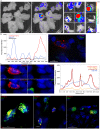Vaginal challenge with an SIV-based dual reporter system reveals that infection can occur throughout the upper and lower female reproductive tract
- PMID: 25299616
- PMCID: PMC4192600
- DOI: 10.1371/journal.ppat.1004440
Vaginal challenge with an SIV-based dual reporter system reveals that infection can occur throughout the upper and lower female reproductive tract
Abstract
The majority of new HIV infections occur in women as a result of heterosexual intercourse, overcoming multiple innate barriers to infection within the mucosa. However, the avenues through which infection is established, and the nature of bottlenecks to transmission, have been the source of considerable investigation and contention. Using a high dose of a single round non-replicating SIV-based vector containing a novel dual reporter system, we determined the sites of infection by the inoculum using the rhesus macaque vaginal transmission model. Here we show that the entire female reproductive tract (FRT), including the vagina, ecto- and endocervix, along with ovaries and local draining lymph nodes can contain transduced cells only 48 hours after inoculation. The distribution of infection shows that virions quickly disseminate after exposure and can access target cells throughout the FRT, with an apparent preference for infection in squamous vaginal and ectocervical mucosa. JRFL enveloped virions infect diverse CD4 expressing cell types, with T cells resident throughout the FRT representing the primary target. These findings establish a new perspective that the entire FRT is susceptible and virus can reach as far as the ovary and local draining lymph nodes. Based on these findings, it is essential that protective mechanisms for prevention of HIV acquisition must be present at protective levels throughout the entire FRT to provide complete protection.
Conflict of interest statement
The authors have declared that no competing interests exist.
Figures








References
-
- Joint United Nations Programme on HIV/AIDS. (2010) Global report: UNAIDS report on the global AIDS epidemic. Geneva, Switzerland: Joint United Nations Programme on HIV/AIDS. pp. v.
-
- Shattock RJ, Moore JP (2003) Inhibiting sexual transmission of HIV-1 infection. Nat Rev Microbiol 1: 25–34. - PubMed
-
- Haase AT (2011) Early events in sexual transmission of HIV and SIV and opportunities for interventions. Annu Rev Med 62: 127–139. - PubMed
Publication types
MeSH terms
Grants and funding
LinkOut - more resources
Full Text Sources
Other Literature Sources
Medical
Research Materials

